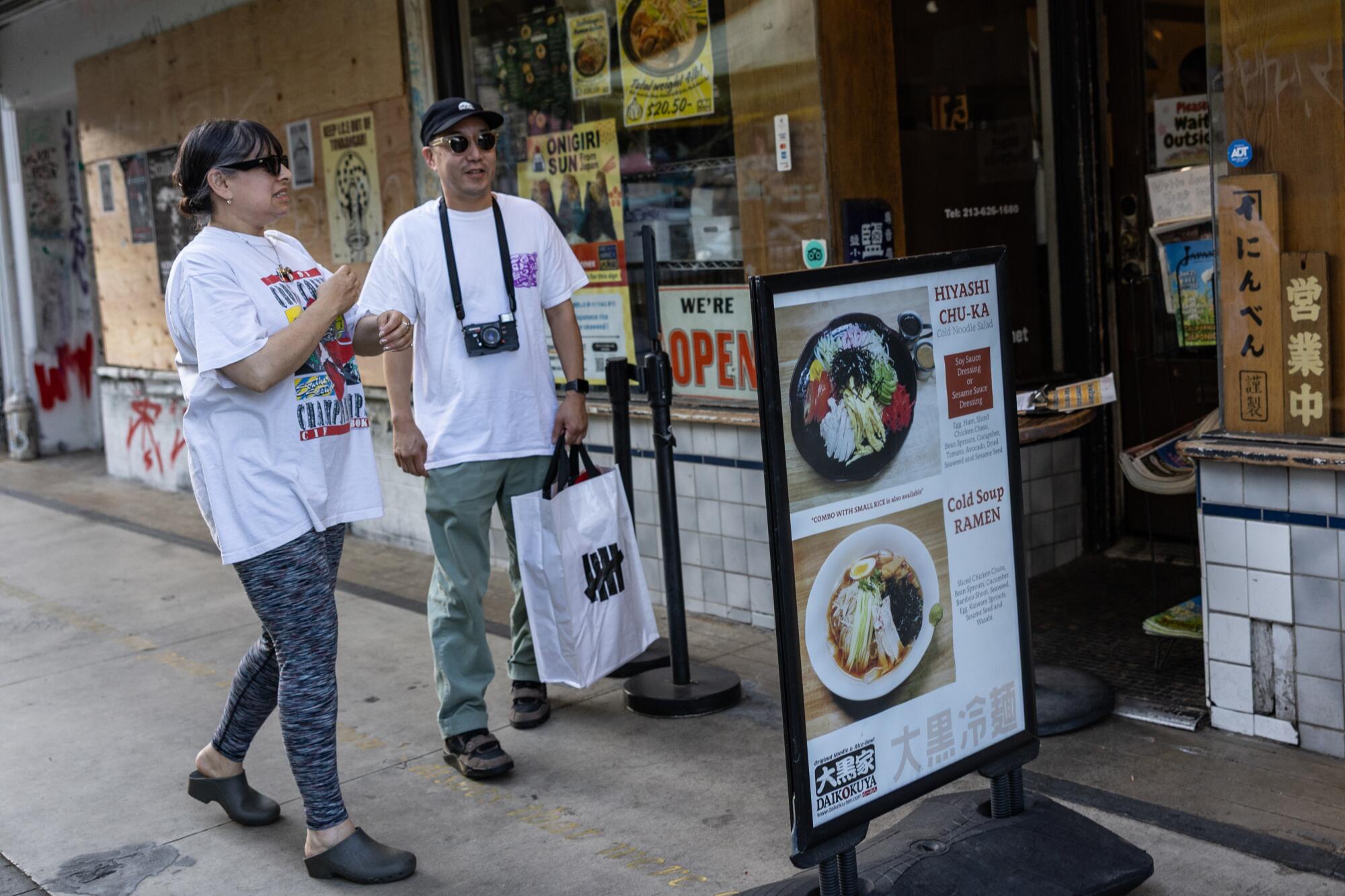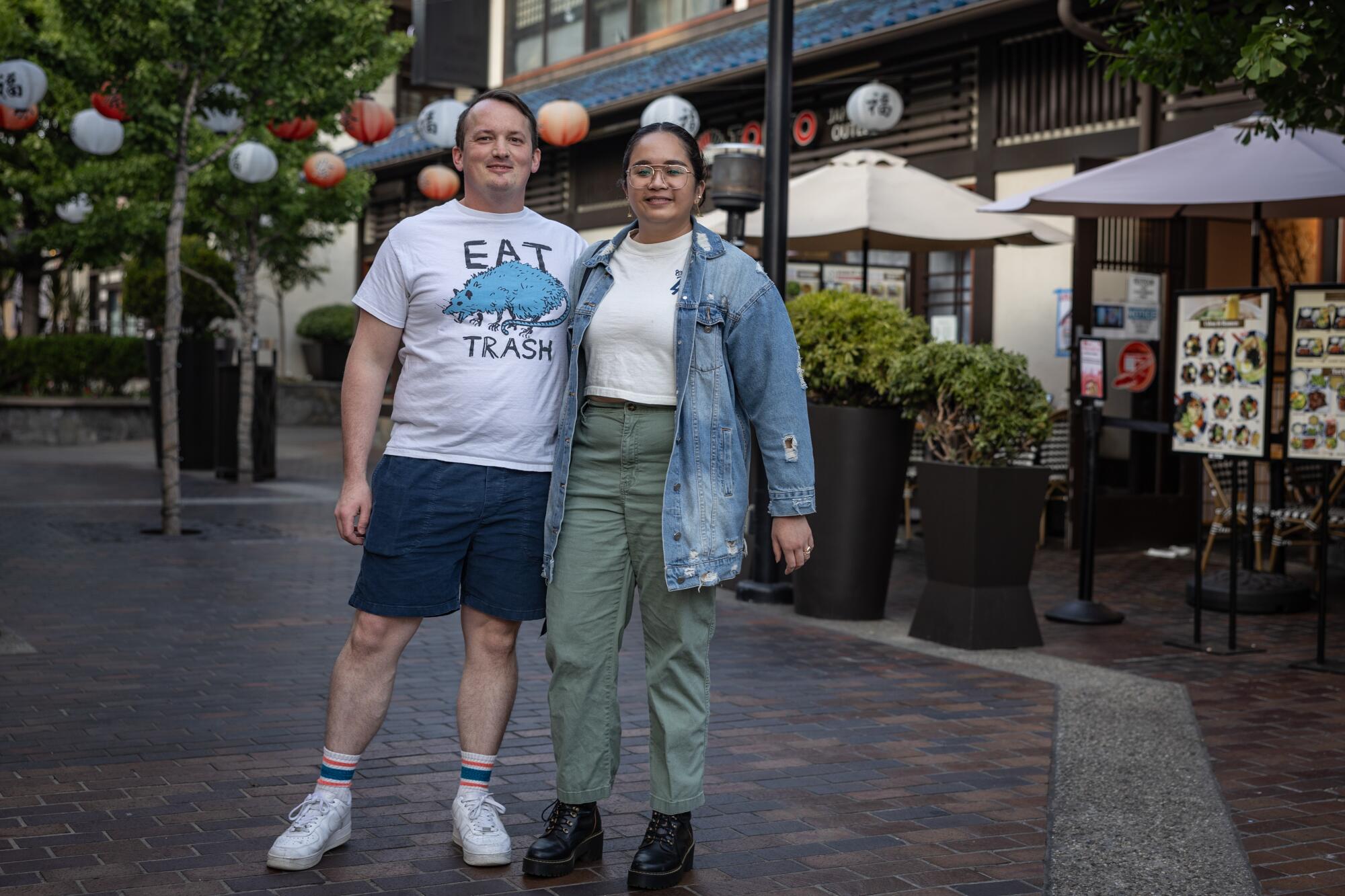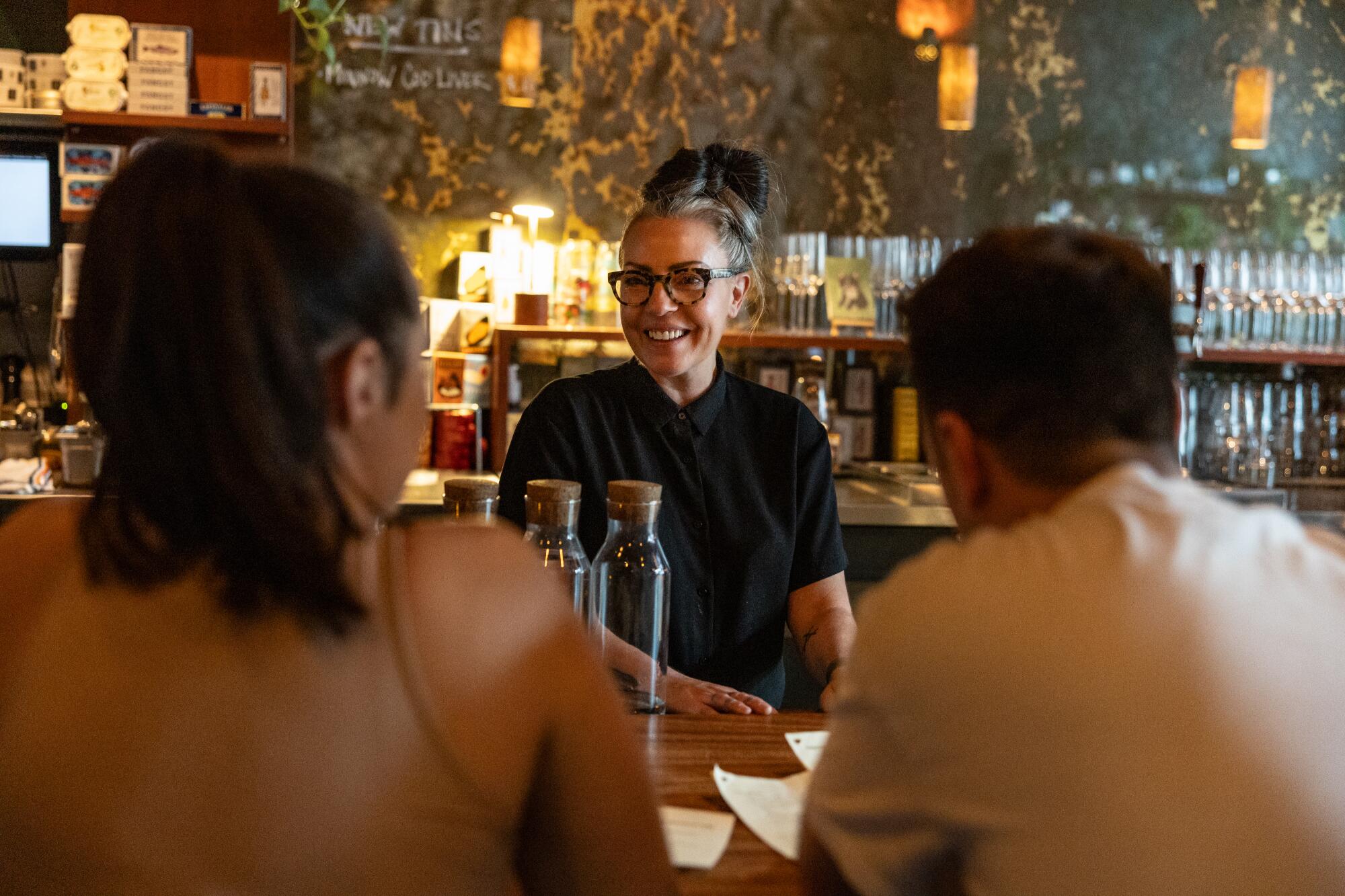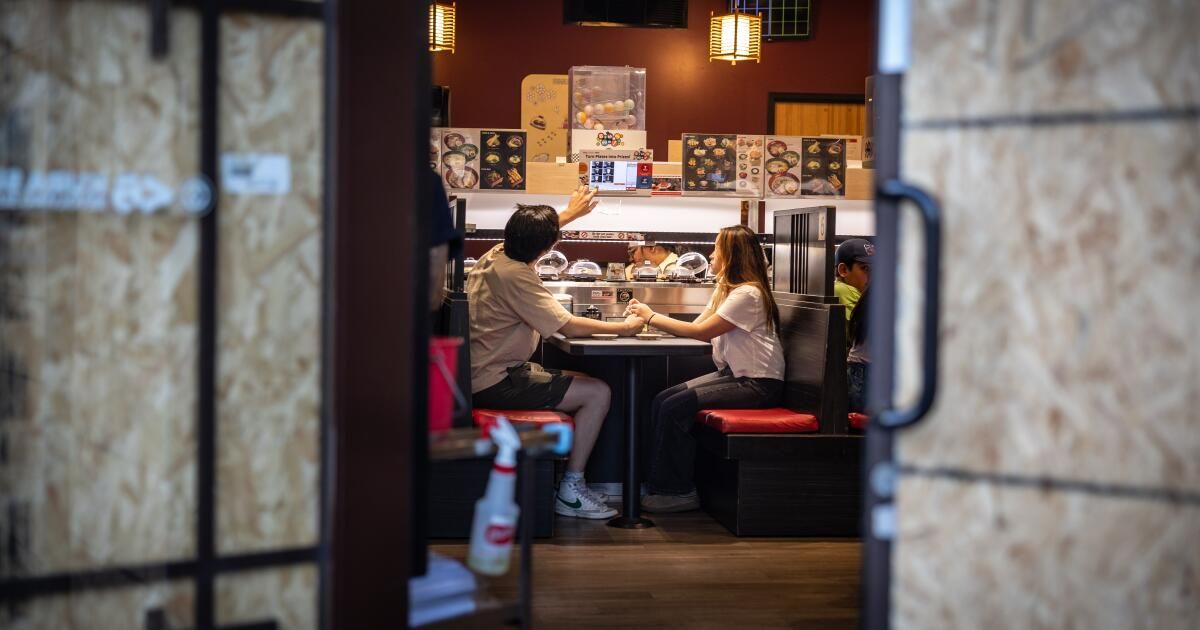It sounded like the alarm for a severe weather warning. At 8:19 pm on Monday night, my phone rang with a public security alert that was in its place of 10 pm to 6 am in downtown Los Angeles. It arrived just when I cried the hill on the South 110 highway that offers a view of the city below.
I was on my way to meet a friend for dinner in Kinjiro, a snug Izakaya in the heart of Little Tokyo.
The area is one of the neighborhoods of the center most seriously affected by the sequels of the recent demonstrations that protest the immigration policies of President Trump and the resulting raids.
Many of the windows in Little Tokyo were tapped during the demonstrations that took place in the area after ice immigration raids.
(Jason Armond / Los Angeles Times)
The remaining touch of Mayor Karen Bass, promulgated a week before in an effort to quell any chaos associated with the demonstrations, meant that the streets were empty. It was the last obstacle in a list in constant expansion of challenges for Los Angeles restaurants, which in the last five years have faced drastic falls in the businesses of a pandemic, strikes and fires of Hollywood writers.
Throughout the 2nd street, the windows and the doors were hidden behind the plywood. Graffiti with words of election for the police and the application of immigration and customs covered almost all surfaces.
The frequently bustling square of the Japanese village, where buyers have dinner at a rotating sushi bar and stopped for corn dogs full of cheese, was desolate. When I arrived at Izakaya, it was clear that they were closed. The windows had been addressed and a security door was dragged on the entrance.
We conducted Bavel in the district of the Arts, curiosity to see if one of the most reserved restaurants in the city was feeling the effects of the curfew, which covered the city center area between highways 5 and 10 and from 10 to 10 to 110 and 5 highways merger.
You can probably measure the status of dinner in Los Angeles for the fullness of the dining room in Ori Menashe and the Resto de Genevieve Gergis Restaurant. A last -minute table at 8 pm on any other night? No chance. When we arrived as visitors, we found a patio that was mostly empty and few customers at the bar and a dining room that felt devoid of the usual Bavel energy. A rapid displacement during the next reserves of the week in Openable showed multiple openings every night.
I drove home beyond the curfew, hoping to see a kind of control point or maybe even a greater police presence. There was not a single car or police manager. All the streets were open.
The curfew of the 8 pm, first issued on June 10, changed to a curfew at 10 pm on Monday. On Tuesday, the curfew was completely lifted, but many restaurants in the center are still struggling to fill their dining rooms.

A portrait of chef Jon Yao from the Kato restaurant. The Restaurant of the Arts District saw a significant fall in the reserves after the curfew and recent manifestations in the center.
(Mariah Tauger / Los Angeles Times)
Last week, the Kato restaurant lost 80% of its reservations. Jon Yao, Ryan Bailey and Nikki Reginaldo's Arts District Menu Restaurant celebrates Yao's education in the San Gabriel Valley. The restaurant No. 1 was appointed on the La Times 101 list three times. Earlier this week, Yao won the James Beard award for the best chef in California. If there is a destination restaurant in the center of Los Angeles, this is all.
On Tuesday, in light of the touch of remained raised, the restaurant was still looking for a 70% drop in reservations for next week.
“The direct impact of the representation of DTLA's media is insecure, which is not, has impacted Kato immediately, and we were forced to close two nights,” says Bailey.
On Friday, around 20 of the canceled reserves were for dinners reserved weeks and months in the future.
“I had two specific cases in which the guest called to say that they were canceling their next trip to Los Angeles based on not feeling safe in Los Angeles,” says Bailey.

Kaminari Gyoza Bar Publications “We are open” for visitors to know that the business is open in Little Tokyo. The area was the epicenter of recent immigration protests.
(Jason Armond/Los Angeles Times)
“The optimistic one expects the curfew, especially given the uprising now, does not cause long -term damage to the city center,” says Cassy Horton, co -founder of the DTLA residents association. The organization works to create a prosperous urban community in the center that supports new and existing residents in the area.
“That is why we have been advocating so strongly to ensure that our small businesses can open,” says Horton. “We need our neighbors throughout the region to join behind the center at this time because we need their support.”
Hours after the curfew lifted on Tuesday, the center of the city began to show signs of giving life again.

Julia M. Leonard and Kevin Uyeda of the Echo Park await a table in Daikokuya in Little Tokyo.
(Jason Armond / Los Angeles Times)
Just before 7 pm, a line began to form in Daikokuya in Little Tokyo. The small Ramen store is known for perpetual waiting as it is for its smoking bowls of Tonkotsu Ramen. It was a hopeful view for a week of uncertainty, in an area that was the epicenter of the demonstrations.
“We review with our friends who live here and were very aware of coming tonight,” says Kevin Uyeda. He went to Ramen with his resident partner of Echo Park, Julie M. Leonard, both anxious to make the short trip to Little Tokyo for dinner.
“I think there has been a lot of wrong information about protests and levels of everything,” says Leonard. “I don't think the left touch was necessary. Most of the protests were peaceful.”

The diners enjoy a meal at the Korean restaurant Jincook in Little Tokyo. The staff saw twice the number of customers after the recent curfew of the center was lifted.
(Jason Armond / Los Angeles Times)
A doors below, in the Korean restaurant Jincook, the staff removed the tables that covered the windows that afternoon.
“It's sure to come here,” says Jincook Hendrik server. “We want people to know that we are open.”
In the Japanese square of the town, the strollers rolled along the winding catwalk with customers drinking. The residents of the Renee Sogueco and Chris Ciszek Arts District brought exchanges of recent stops in Daikokuya and Fugetsu-Do, the confectionery of Mochi and Mango of more than 100 years in the first street.
“Once we heard the curfew lifted, we wanted to leave,” says Sogueco. “We have really felt bad so with all affected immigrants companies. Daikokuya was quite busy, but not as busy as we have seen.”

The residents of the Chris Ciszek Arts District, on the left, and Renee Sogueco enjoy one night in the Japanese village of Little Tokyo hours after the city is lifted from the city.
(Jason Armond / Los Angeles Times)
Ciszek's parents decided to make Virginia's trip to visit, despite friends at home questioning the decision.
“People are seeing many very cured images online,” says Ciszek. “They do not reflect what has been happening in the center. For what we have seen, the protesters have been happy, dancing, playing music, not violently disruptive.”
I took a short trip to the west to the South Broadway block that houses Grand Central Market and found people eating tacos at the tables that are aligned on the sidewalk. A few locals took wine glasses at the nearby Kippered, the bar and the fish bar of Lydia Clarke and Reed Herrick.
“With everything chosen, it does not feel attractive for tourists or people to come,” says Clarke. “We still need people outside the neighborhood, so people do not forget how great the center is, how easy it is to come and move on to a couple of places.”

The co -owner of Kippered, Lydia Clarke, talks with customers in her print fish and wines in downtown Los Angeles. The neighborhood showed signs of life after the city lifted a curfew for stop the disturbances after the ongoing immigration raids.
(Jason Armond / Los Angeles Times)
With the lifting touch, many restaurants that closed, temporarily opened for lunch or moved to completely new locations outside the center of Los Angeles, began to announce that they would return to regular commercial operations.
Lasita, the Philippine Asta and the Wine Bar in Chinatown, reopened for dinner. The Italian restaurant of Steve and Dina Samson, Rossoblu, which worked as an emerging window in Playa Vista during the weekend, returned to dinner service in its fashion district location recently.
“I know we try a lot in the center, but when things become more difficult, our hearts become bigger,” says Clarke. “I feel very hopeful again.”












